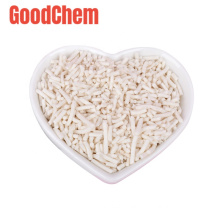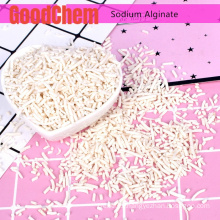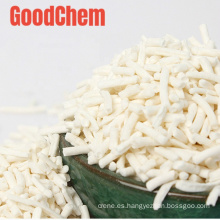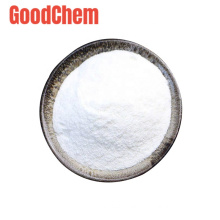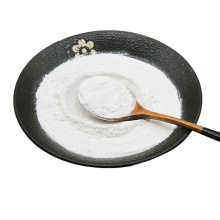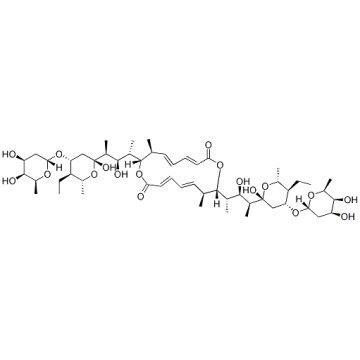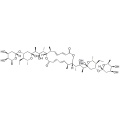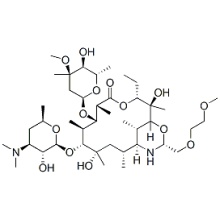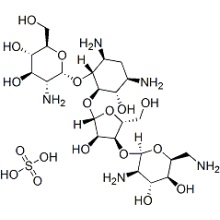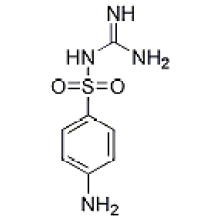.cp_wz tabla {borde superior: 1px sólido #ccc; borde izquierdo: 1px sólido #ccc; } .cp_wz table td {borde derecho: 1px sólido #ccc; borde inferior: 1px sólido #ccc; padding: 5px 0px 0px 5px;} .cp_wz table th {border-right: 1px solid #ccc; border-bottom: 1px solid #ccc; relleno: 5px 0px 0px 5px;} \ n Peso molecular: 1025.27 Elaiophylin muestra actividad antiprotozoaria contra Plasmodium falciparum K1a y Trypanosoma brucei brucei GUTat 3.1 cepas con IC50 de 0.36 μM y 0.45 μM, respectivamente. \ n Actividad biológica La azalomicina-B posee un antibacteriano actividad contra bacterias Gram-positivas. La concentración inhibitoria mínima (MIC) de Azalomicina-B contra Staphylococcus aureus (SG 511, 285 y 503) es 1,52 µM. La CMI de Azalomicina-B contra Streptococcus pyogenes es de 0,76 µM y 1,52 µM para las cepas 306A y 77A, respectivamente. La CMI de Azalomicina-B contra S. faecium A es 3,05 µM. In vitro, Azalomicina-B muestra una actividad antibiótica como potenciador de la eficiencia de la fermentación ruminal y también inhibe la producción de ácido láctico en el fluido ruminal con IC5O de 2,14 μM. Azalomicina-B inhibe las ATPasas de tipo P tales como la ATPasa de tipo P, dependiente de K + de Escherichia coli, sin afectar en absoluto a las ATPasas de tipo F y tipo V. Azalomicina-B muestra el potente efecto citotóxico sobre células de fibroblastos de ratón L929, células de leucemia humana K562 y cultivos de células HeLa con IC50 de 0,29 µM, 0,19 µM y 0,29 µg / ml, respectivamente. Además, Azalomicina-B también produce citotoxicidad en células MRC-5 con IC50 de 0,85 µM. Protocolo (solo como referencia) Ensayo celular: [4]
|
Cell lines
|
L92, K562 and HeLa cells
|
|
Concentrations
|
0-10 μM
|
|
Incubation Time
|
72 hours
|
|
Method
|
The adherent mouse fibroblast cell line L-929 is cultured in Eagle's MEM with 0.35 mg/mL sodium bicarbonate, 100 units/mL penicillin/100 μg/mL streptomycin, 10 mM HEPES, and 10% heat-inactivated FBS at 37 °C in culture flasks. The adherent cells are harvested at the logarithmic growth phase after trypsination using 0.05% trypsin in phosphate-buffered saline (PBS) containing 0.02% EDTA. The nonadherent human leukemia cell line K-562, is cultured in RPMI 1640 medium, supplemented with 100 units/mL penicillin/100 μg/mL streptomycin and 10% FBS in culture flasks. L-929 and K-562 cells are inoculated in 0.1 mL culture medium, containing NaHCO3 without HEPES, per well of the 96-well microplates. The plates are previously prepared with dilutions of the Azalomycin-B in 0.1 mL medium. The microplates are kept for 72 hour at 37 °C in a humidified atmosphere containing 5% CO2. The adherent human cell line HeLa is cultured in MEM Eagle with 100 units/mL penicillin/100 μg/mL streptomycin, 10% FBS, and 2 mM l-glutamine in vented culture flasks. The adherent cells are harvested during the logarithmic growth phase after trypsination with 0.4% trypsin in PBS containing 0.02% EDTA. These cells are seeded with in 0.1 mL culture medium per well of the 96-well microplates. HeLa cells are preincubated 48 hours without Azalomycin-B. The dilutions of Azalomycin-B are carried out on the monolayer of HeLa cells after preincubation time. After incubation, the monolayer of the adherent L-929 and HeLa cells are fixed by glutaraldehyde and stained with a 0.05% solution of methylene blue for 15 minutes. After washing the stain is eluted by 0.2 mL of 0.33 N HCl in the wells. The optical densities are measured at 630 nm in a Dynatech MR 7000 microplate reader. After incubation, the K-562 cells are analyzed using an electronic cell analyzer system CASY 1 and software CASYSTAT for determination of IC50 values. The IC50 values are determined by integrated software CASYSTAT.
|
Conversión de diferentes modelos de animales basados en BSA (valor basado en datos del Borrador de Directrices de la FDA)
|
Species
|
Baboon
|
Dog
|
Monkey
|
Rabbit
|
Guinea pig
|
Rat
|
Hamster
|
Mouse
|
|
Weight (kg)
|
12
|
10
|
3
|
1.8
|
0.4
|
0.15
|
0.08
|
0.02
|
|
Body Surface Area (m2)
|
0.6
|
0.5
|
0.24
|
0.15
|
0.05
|
0.025
|
0.02
|
0.007
|
|
Km factor
|
20
|
20
|
12
|
12
|
8
|
6
|
5
|
3
|
|
Animal A (mg/kg) = Animal B (mg/kg) multiplied by
|
Animal B Km
|
|
Animal A Km
|
Por ejemplo, para modificar la dosis de resveratrol utilizada para un ratón (22,4 mg / kg) a una dosis basada en el BSA para una rata, multiplique 22,4 mg / kg por el factor Km para un ratón y luego divida por el factor Km para una rata. Este cálculo da como resultado una dosis equivalente para ratas de resveratrol de 11,2 mg / kg.
|
Rat dose (mg/kg) = mouse dose (22.4 mg/kg) ×
|
mouse Km(3)
|
= 11.2 mg/kg
|
|
rat Km(6)
|
Información química
|
Molecular Weight (MW)
|
1025.27
|
|
Formula
|
C54H88O18
|
|
CAS No.
|
37318-06-2
|
|
Storage
|
3 years -20℃Powder
|
|
6 months-80℃in solvent (DMSO, water, etc.)
|
|
Synonyms
|
Azalomycin-B
|
|
Solubility (25°C) *
|
In vitro
|
DMSO
|
49 mg/mL
(47.79 mM)
|
|
Water
|
<1 mg/mL
(
|
|
Ethanol
|
5 mg/mL
(4.87 mM)
|
|
|
|
Stock Solution (1ml DMSO)
|
1mM
|
10mM
|
20mM
|
30mM
|
|
Mass(mg)
|
1.02527
|
10.2527
|
20.5054
|
30.7581
|
Grupos de Producto : Otros > Otro
